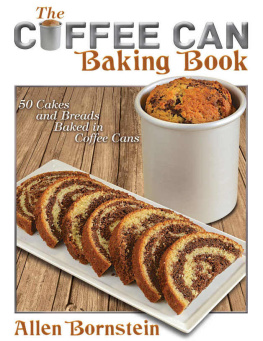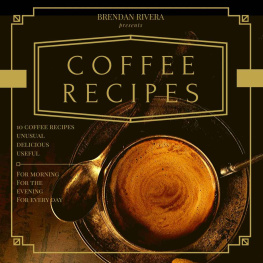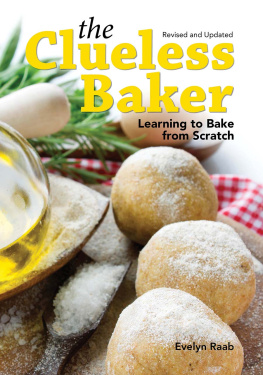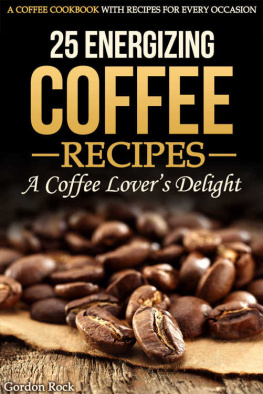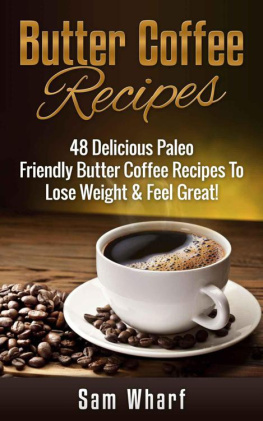
2015 Allen Bornstein
All Rights Reserved.
No part of this publication may be reproduced, stored in a retrieval system, or transmitted, in any form or by any means, electronic, mechanical, photocopying, recording, or otherwise, without the written permission of the author.
First published by Dog Ear Publishing
4010 W. 86th Street, Ste H
Indianapolis, IN 46268
www.dogearpublishing.net

ISBN: 978-1-4575-3432-4
Library of Congress Control Number: has been applied for
This book is printed on acid-free paper.
Printed in the United States of America
Acknowledgements
I have so many people to thank for helping make this book possible, that it is hard to know where to begin.
First, Id like to begin by thanking my friend Melba Griffin, at whose home I first ate the pumpkin bread baked in a coffee can that inspired this book.
Many thanks also go to a number of people listed below:
To my brother David Bornstein and his wife Meryl, who acted as critical tasters. Meryl is a gourmet cook who I turned to many times for guidance.
To my daughter Rachel and son Mark for their moral support. A special thanks to Mark, for his help in editing this book and getting thru the publishing process.
To my dear friends, husband and wife, Lueb Popoff and Annie Forester, for their taste testing and suggestions. Lueb, who is a former chef, provided invaluable feedback along the way for which I am incredibly grateful.
To Deb Hultgren for sharing some of her recipes and also being one of my taste testers.
To Pat Parsons, who has been a baker for many, many years and who tested some of the recipes close to sea level in California. She also offered some valued recommendations.
To Keith and Jennifer Flodstrom, my neighbors, who also taste tested most of the recipes.
A special thanks to copy editor Christine Davidson for her fine editing and suggestions in writing this book.
To all the people at Dog Ear Publishing for their help in making the publishing experience a pleasant one.
A big thank you to Greg Skipper of Fat Daddios bakeware company for helping to make available a baking can that is the approximate size of the old coffee cans and is safe for baking.
Contents
Preface
The inspiration for this book came from a dear friend, Melba Griffin, who now lives in Texas. When she and her husband Jerry lived in Colorado, they would often have me over for dinner and Melba would serve pumpkin bread baked in a coffee can. I usually ate more than my share of this great tasting bread and it fascinated me that it was baked in a coffee can. Melba gave me the recipe and I baked it a few times. I then started to wonder what other cakes or breads could be baked in the cans. Only a few breads (such as Brown Bread) or cakes are still traditionally baked in coffee cans . After a few successful attempts at other recipes, I decided that it might be possible to put together a book on baking various cakes and breads in the coffee cans. What I didnt realize was how much work it was to develop, test, and write a book of recipes. Now, I have a much greater respect for anyone who has ever developed a recipe or written a cookbook.
This book is written to help provide people with a way to have some fun with their families while baking cakes and breads - in coffee cans . It is not meant to be a book on the fine art of baking - but instead a starting point to bake things the old fashioned way - in a can. Once you start doing this you will undoubtedly create new recipes to bake or ways to improve the recipes that I have put together. Most of all, you should have some fun baking these cakes and breads. The recipes are fairly forgiving and in general are not complicated. Some do take a little more time and preparation than others. When you look thru the recipes you will notice that in order to keep things easy, many of them follow similar methods of preparation. Please also keep in mind that any of these recipes may be baked in regular baking pans. But, you will have to adjust the baking time depending on the size and shape of the pan.
There are three things that you should keep in mind when using this book:
1) Baking these recipes should be fun.
2) A recipe is just a guide. Recipes are not the final word on how to make any particular item, but are there to help you. Conditions such as temperature, humidity, altitude, brand of products used, your oven, your technique, and other things can change the outcome of the food that you are preparing.
3) It is OK to make mistakes. Mistakes make us think and force us to explore how to do better. In testing these recipes, l have probably made every mistake that you can think of: I have accidentally turned a can of batter over in the oven, Ive used the wrong yeast or leavening agent, forgotten to set the timer, left out ingredients and doubled some ingredients, I have added the wrong ingredient, I have over baked and under baked, I have let yeast breads rise too long and have kneaded doughs too short a time and too long a time. I cant even remember all the errors I have made. But when you do make errors, laugh at what you did and vow to never do it again. Keep in mind, these recipes are very forgiving. And even if you do make mistakes, you can usually eat them. The spilled batter in the oven would definitely be an exception.
I hope you enjoy using The Coffee Can Baking Book!
Introduction
Coffee Cans:
Baking in coffee cans goes back to the early 1900s, when people didnt necessarily have all the fancy pots and pans that we have today. They used whatever they had and since coffee came in metal cans that held a pound of coffee, it was handy to use them for baking and for cooking. Those cans were unlined and had paper labels that could be easily removed. Today, coffee usually comes in paper bags, pressed cardboard or plastic containers. Of the companies that still use metal cans today, many use cans that are painted on the outside and are often lined on the inside with a plastic coating or enamel. Do not use these cans for baking.
It is very difficult to find the old style coffee cans that are safe for making baked goods. Today, coffee rarely comes in cans. Cans used for baking should not be rusted, should not be soldered with lead or lined or contain any other harmful metals or chemical agents that can leach into the baked goods when repeatedly used. Since cans that are safe for baking are almost impossible to find, I have been able to work with a major manufacturer to make safe pans that can be substituted for the old coffee cans and used with the recipes in this book. These pans are not exactly the same size as the old coffee cans, but hold almost the exact same volume as the old cans. They are slightly shorter and a little wider than the original cans. They are also not ribbed like the old coffee cans and that makes it easier to slide baked products out of the pans when they are done. These are high quality anodized aluminum pans made by well-known bakeware company Fat Daddios. Details on how you can purchase these pans with the book, or separately, are listed at the back of this book.
Caring for the Cans:
Once the bread or cake has been removed from the cans and the cans have cooled, it is important to wash and dry them thoroughly. The old coffee cans are not stainless steel and may rust. Do not use harsh abrasives, chemicals, steel wool, or sharp cleaning tools when cleaning the coffee cans or anodized aluminum cans. The cans from Fat Daddios are high quality aluminum pans that are anodized for safety and performance.
Next page
